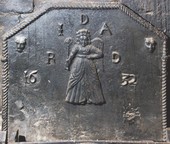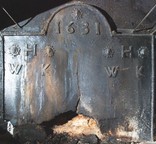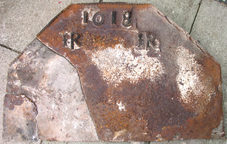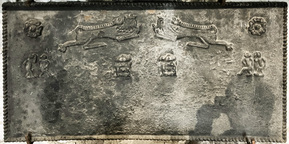-
1242
Description: Canted rectangular shape; twisted rope edging (top and sides); top centre, date, 1638, with uneven figures (oversize 3), between two fleurs-de-lys; four fleurs-de-lys, lying horizontally, down each side; below date, slender 'T' shape above a slender 'M' shape, with initials 'W' and 'B' separated by the 'T' shape.
Notes: The distinctive fleur-de-lys has not been noted on any other fireback. Purchased by Birmingham Museums in 1982 at the sale of the contents of the house ‘Hildercroft’ on Highfield Road in Hall Green, Birmingham.
Inscription: 1638 / W T B / M
- Decoration tags:
- rectangular with canted top corners (shape)
- rope (edging)
- simple stamps
- carved stamps
- heraldic
- text
- objects
Manufactured: in 1638 in England.
Current location: Blakesley Hall, Blakesley Road, Yardley, West Midlands, England.
(part of the Birmingham Museums Trust museum group)
- Attached to series:
- Date & initials firebacks
-
1219
Description: Rectangular shape; twisted rope edging (top and sides); top centre, cross-shaped arrangement of four fleurs-de-lys between to crosses formed of lengths of twisted rope with single fleurs outside and beyond each of them a dagger, point upwards; to the right, a single fleur; bottom centre, a triangle formed of three lengths of twisted rope, vertex to the bottom, between two non-identical groups of three fleurs arranged in star pattern.
Notes: The style of the fleurs-de-lys associates this fireback with a series with several examples. The dagger type (approximate length 32cm) is different to others in the same series. Bishop & Miller Auctioneers, Stowmarket, 27 Jan 2022, lot 88 (£110).
- Decoration tags:
- rectangular (shape)
- rope (edging)
- simple stamps
- carved stamps
- heraldic
- apotropaic
- objects
Manufactured: in the mid- to late-16th century in the Weald area of England.
Current location: not known.
- Attached to series:
- Royal series
- Knife & Dagger stamp firebacks
-
204
Description: Canted rectangle; twisted rope edging (top and sides); Tudor royal shield and Garter with crown above, between lion and unicorn supporters; initials separated by crown; a small ring and bar are placed to the left of the unicorn’s mouth.
Notes: The Tudor shield and crown feature on many Wealden firebacks, and have here been reused with Jacobean supporters; their stamps are derived from standing models.
Inscription: I R
Arms: Tudor royal
- Decoration tags:
- rectangular with canted top corners (shape)
- rope (edging)
- carved stamps
- individual letters
- heraldic
- armorial
- royal
Manufactured: in the early-17th century possibly at Pounsley Furnace, Framfield in the Weald area of England.
Current location: St Mary's Abbey, Blanchland, Northumberland, England.
- Attached to series:
- Pounsley series
- Jacobean royal armorial firebacks
-
208
Description: Canted rectangle; twisted rope edging (top and sides); quasi-symmetrical arrangement of four fleurs-de-lys in star, top centre, two fleurs each side along top edge, single fleurs beneath outer top fleurs; short rope length in vertical and inverted 'V' shapes each side between top fleurs; ?dagger handle irregularly positioned centre left and right.
Notes: The style and shape of the fleurs-de-lys is unique to a particular series of firebacks, suggesting the same source; the 'V' shapes may have apotropaic significance. A sketch of this fireback c.1891 is in the collection of J. Starkie Gardner's sketch books at the Victoria and Albert Museum, Archive of Art and Design (AAD/2014/8); at the time of drawing it was stated to be in the ownership of one Simmons, a furniture dealer of Lewes.
- Decoration tags:
- rectangular with canted top corners (shape)
- rope (edging)
- simple stamps
- carved stamps
- heraldic
Manufactured: in the mid-16th century in the Weald area of England.
Current location: in private hands, Cox Green, Berkshire, England.
- Attached to series:
- Royal series
-
120
Description: Rectangular; rope edge (top and sides); rose and crown within a shield, stamped twice, both inverted, down centre; rectangular stamp with griffin, twice, in top corners.
Notes: Five other firebacks bearing these stamps are known: one is also in Hastings, and one, dated 1569, is at Hadlow Down, Sussex. The locations of the other three are not known. Formerly part of the Ade Collection (from Grove Hill, Hellingly, Sussex).
- Decoration tags:
- rectangular (shape)
- rope (edging)
- carved stamps
- heraldic
Manufactured: in the mid- to late-16th century in the Weald area of England.
Current location: Hastings Museum and Art Gallery, John's Place, Bohemia Road, Hastings, East Sussex, England.
Museum number: HASMG: 1952.51.11 (part of the Hastings Museum museum group)
Citation: Baines, J. M., 1958, Wealden Firebacks (Hastings Museum).
- Attached to series:
- Griffin series
-
812
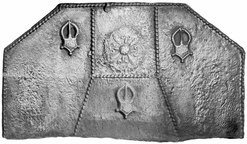 ? x ? mm
? x ? mmDescription: Canted rectangle; twisted rope edging (top and sides); divided by rope lengths into four panels: centre top, square; centre bottom, trapezium; sides, irregular hexagons; buckle stamp repeated three times, in bottom and side panels; top centre panel, circular flower stamp with fleur de lys on each petal.
Notes: The buckle stamps suggest a connection with the Pelham family; illustrated in Butterfield 1916, where it was stated to have been in a house at Herstmonceux, Sussex..
- Decoration tags:
- rectangular with canted top corners (shape)
- rope (edging)
- simple stamps
- carved stamps
- planklines
- heraldic
- objects
Manufactured: in the late-16th century in the Weald area of England.
Current location: not known.
Citation: Butterfield, W. R., 1916, 'Old Wealden Firebacks', The Connoisseur, 46, pp. 197-209.
- Attached to series:
- Pelham family firebacks
- Metalware stamp firebacks
-
1027
Description: Canted rectangle; inset twisted rope edging (top and sides); stamp formed of a statuette of an standing angel with left hand at the waist, and holding a sceptre in the right hand; date split either side of angel; initials 'RD' split above date; initials 'IDA' in triad above angel; small face stamp in each top corner.
Notes: The identity of those to whom the initials refer is not known; the use of the angel statuette is a rare inclusion of a religious motif on an English fireback. A variant of this fireback is at Flaxley Abbey, Gloucestershire (no. 293).
Inscription: IDA [triad] / R D / 16 32
- Decoration tags:
- rectangular with canted top corners (shape)
- rope (edging)
- carved stamps
- individual letters
- individual numbers
- text
- humans
Manufactured: in 1632 in the Forest of Dean area of England.
Current location: The Lygon Arms, High Street, Broadway, Worcestershire, England.
- Attached to series:
- Figurine firebacks
- Angel series
- Date & initials firebacks
-
1028
Description: Arched rectangular shape; twisted rope edging (top and sides); date in arch; initial triads in top shoulders of plate; small mask patera repeated once above date and on each side of 'H' initials.
Notes: The small mask patera has not been seen on other firebacks.
Inscription: 1631 / WHK [triad] WHK [triad]
- Decoration tags:
- rectangular with round arch (shape)
- rope (edging)
- carved stamps
- individual letters
- individual numbers
- text
- objects
Manufactured: in 1631 in England.
Current location: The Lygon Arms, High Street, Broadway, Worcestershire, England.
- Attached to series:
- Date & initials firebacks
-
811
Description: Canted rectangle; twisted rope edging (top and canting only); centre top, date (written as 1018); below to left and right, initials.
Notes: It has been suggested that the initials IR relate to King James I but the lack of any other royal decoration makes this unlikely.
Inscription: 1618 / IR IR
- Decoration tags:
- rectangular with canted top corners (shape)
- rope (edging)
- individual letters
- individual numbers
- text
Manufactured: in 1618 possibly in the Shropshire area of England.
Current location: 50, Church Street, Broseley, Shropshire, England.
- Attached to series:
- Date & initials firebacks
-
1300
Description: Rectangular shape; twisted rope edging; top centre, a lion passant on the right and a lion passant guardant sinister on the left; in each top corner, a four-petalled Tudor rose; below each rose, two 'imps', one with right arm raised, the other with both arms lowered, the pair on the left facing to the right and the pair on the right facing to the left; below each lion, a crowned, four-petalled Tudor rose.
Notes: A spurious fireback based on, and probably adapted from, a 16th century English back, this and its copies include remodelled rope edging, lions and 'imp' figures, all probably dating from the restoration of Bunratty Castle in the 1960s.
Copies of this fireback are known.
- Decoration tags:
- rectangular (shape)
- rope (edging)
- carved stamps
- heraldic
- animals
- humans
- plants
Manufactured: in the mid-20th century in Ireland.
Current location: Bunratty Castle, Bunratty, County Clare, Republic of Ireland.
- Attached to series:
- Royal series
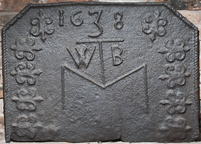
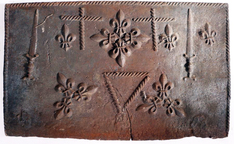
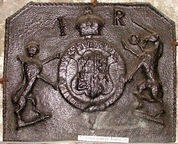

.jpg)
